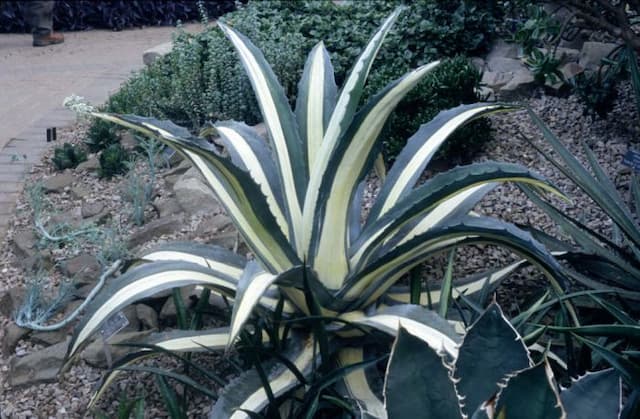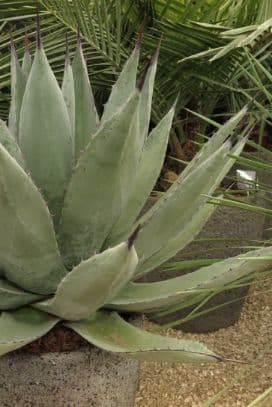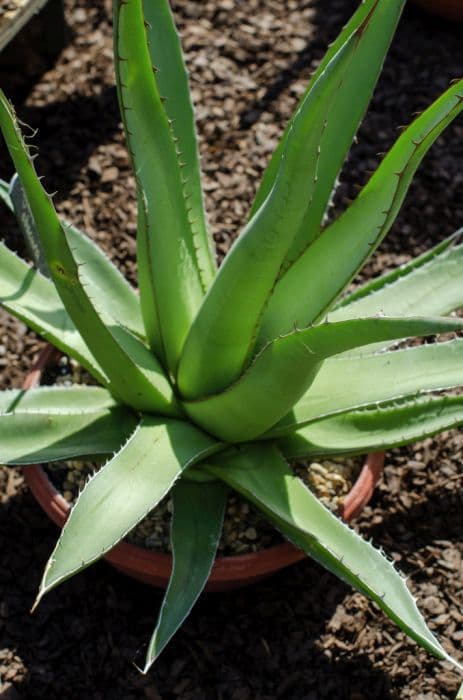Plantain Lily Hosta 'Paradigm' (v)

ABOUT
Hosta 'Paradigm' is an ornamental plant notable for its distinctive foliage. The leaves are large and heart-shaped with a unique color pattern. They possess a bright golden-yellow center that contrasts with dark green margins, creating a variegated effect. The leaves are somewhat wavy and corrugated, adding texture and visual interest to the plant. In addition to its attractive leaves, Hosta 'Paradigm' produces tall stalks that bear lavender flowers, which can add a vertical element to the garden and attract pollinators. The flowers are bell-shaped and appear on the stems that rise above the foliage clump. The overall appearance of Hosta 'Paradigm' is lush and vibrant, with a striking combination of colors and shapes that can enhance shaded garden areas or container plantings.
About this plant
 Names
NamesFamily
Asparagaceae
Synonyms
Plantain Lily, Funkia
Common names
Hosta 'Paradigm'.
 Toxicity
ToxicityTo humans
Hostas, including the Hosta 'Paradigm' variant, are generally considered to be non-toxic to humans. Ingesting parts of this plant typically does not result in poisoning or serious side effects for humans. However, it is always advised to avoid eating ornamental plants as their effects can vary among individuals and some people may have sensitivities or allergic reactions.
To pets
Hostas are known to be toxic to pets, such as cats and dogs. If a pet ingests any part of a Hosta plant, they may experience symptoms of poisoning which can include vomiting, diarrhea, and depression. In severe cases, ingestion can lead to more serious consequences and warrant immediate veterinary attention. Pet owners should take precautions to keep their pets away from Hostas to prevent accidental ingestion.
 Characteristics
CharacteristicsLife cycle
Perennials
Foliage type
Deciduous
Color of leaves
Variegated
Flower color
Lavender
Height
1-2 feet (30-60 cm)
Spread
2-3 feet (60-90 cm)
Plant type
Herb
Hardiness zones
3-9
Native area
Asia
Benefits
 General Benefits
General Benefits- Aesthetically Pleasing: Hostas are known for their lush foliage and the 'Paradigm' variety offers attractive variegated leaves that add visual interest to any garden.
- Shade Tolerance: Like most hostas, 'Paradigm' thrives in shady areas where other plants might struggle, making it a great choice for filling in dark corners of the landscape.
- Low Maintenance: Hosta 'Paradigm' requires minimal care once established, needing only occasional watering and the removal of any spent leaves or stems.
- Drought Resistance: Once established, 'Paradigm' can tolerate periods of dryness, making it suitable for gardens in regions with occasional droughts.
- Pest Resistance: While slugs and deer may find hostas attractive, 'Paradigm' is relatively resistant to damage compared to some other varieties.
- Long Living: Hostas are perennial plants, and with proper care, they can live for many years, returning each spring with renewed growth.
- Versatility: Hosta 'Paradigm' can be used in a variety of landscape designs, including borders, woodland gardens, and as ground cover.
 Medical Properties
Medical PropertiesThis plant is not used for medical purposes.
 Air-purifying Qualities
Air-purifying QualitiesThis plant is not specifically known for air purifying qualities.
 Other Uses
Other Uses- Container Gardening: Due to its attractive foliage, Hosta 'Paradigm' can be used in large containers to decorate patios, decks, or balconies, bringing a lush look to urban outdoor spaces.
- Bioindicator: Hostas can be used as bioindicators for garden health, as they are sensitive to changes in soil conditions and can signal when an environment is out of balance.
- Water Garden Accent: The Hosta 'Paradigm' can be planted around water features to create a beautiful contrast with the water and contribute to a serene aquatic garden ambiance.
- Artistic Inspiration: Artists and photographers often use Hostas as subjects or backdrops due to their striking leaves, with variegated patterns that provide visually interesting textures.
- Fabric Dyeing: The leaves of the Hosta 'Paradigm' can potentially be used to create natural green dyes for fabrics, although it's not a common practice.
- Culinary Garnish: In some cultures, the flowers of hostas are used to make an attractive edible garnish, although it's essential to ensure they are free of pesticides and safe to consume.
- Leaf Casting: Crafters sometimes use the large leaves of Hosta 'Paradigm' to create concrete or plaster leaf castings for decorative stepping stones or garden art.
- Education and Study: Hostas, due to their variety and ease of cultivation, are excellent for educational purposes to teach about plant care, hybridization, and horticultural design.
- Ground Cover: Hosta 'Paradigm' can be used as ground cover in shaded areas of the garden where other plants might struggle to thrive.
- Habitat for Wildlife: The dense foliage of hostas provides shelter for small wildlife such as frogs, toads, and beneficial garden insects.
Interesting Facts
 Feng Shui
Feng ShuiThe Hosta is not used in Feng Shui practice.
 Zodiac Sign Compitability
Zodiac Sign CompitabilityThe Hosta is not used in astrology practice.
 Plant Symbolism
Plant Symbolism- Resilience: Hostas are known for their hardiness and ability to thrive in shade, representing the ability to endure and prosper despite adversity.
- Versatility: With their wide variety of sizes, shapes, and colors, hostas symbolize adaptability and versatility in different conditions.
- Self-care: Hostas require minimal maintenance once established, symbolizing the importance of taking time to nurture oneself without constant effort.
- Peace and tranquility: Often found in serene garden settings, hostas can represent a peaceful and calming presence in one's life.
- Longevity: As perennials that return year after year, hostas can symbolize long life and enduring relationships.
 Water
WaterWater your Hosta 'Paradigm', commonly known as hosta, deeply but infrequently to simulate natural rainfall. The goal is to keep the soil consistently moist but not soggy. During the growing season, water your hostas with approximately one inch of water weekly. Adjust your watering schedule based on rainfall; less water may be needed during wet periods and more during dry spells. Always water at the base of the plant to keep the leaves dry and prevent fungal diseases. It is best to water in the early morning to allow any excess water on the leaves to dry during the day.
 Light
LightHosta 'Paradigm' thrives in partial to full shade. The ideal spot for a hosta is one where it can receive morning sunlight and be protected from the harsh afternoon sun. These plants can also grow in deep shade but may not develop as full and vibrant foliage. Good light conditions for hostas are under the canopy of trees or on the north side of a building, where they receive filtered light without being exposed to direct sun for long periods.
 Temperature
TemperatureHostas, such as the Hosta 'Paradigm', prefer moderate temperatures and can generally tolerate temperatures from 30°F to 85°F. They are hardy and can survive short periods of colder weather, even frost, but the foliage will die back when temperatures start falling consistently below 50°F. The ideal temperature range for active growth is between 60°F and 75°F.
 Pruning
PruningPrune your Hosta 'Paradigm' primarily to remove dead or damaged foliage, which can be done at any time during the growing season. The best time for a general cleanup, however, is in the late fall or early spring before new growth begins. Remove old foliage to prevent disease and make space for fresh leaves. Pruning is not needed for growth but helps keep the plant healthy and looking its best. Hostas may also be pruned in late summer to remove flower stalks after they have bloomed to divert energy back to the leaves.
 Cleaning
CleaningAs needed
 Soil
SoilHostas prefer moist, well-draining soil with high organic content. A mix containing one part garden soil, one part compost or well-rotted manure, and one part perlite or coarse sand is ideal. The soil pH should be slightly acidic to neutral, ideally between 6.5 and 7.5.
 Repotting
RepottingHostas, commonly known as Plantain Lilies, typically do not need to be repotted frequently. Repotting is generally required only when they outgrow their current container or the soil is exhausted, which may be every 4 to 5 years.
 Humidity & Misting
Humidity & MistingPlantain Lilies thrive in an environment with average humidity levels. They are adaptable to the typical humidity found outdoors and do not require any special humidity adjustments when grown in garden settings.
 Suitable locations
Suitable locationsIndoor
Place in bright, indirect light with cool temperatures.
Outdoor
Plant in shade to part shade; water regularly.
Hardiness zone
3-8 USDA
 Life cycle
Life cycleHosta 'Paradigm'—commonly known as Plantain Lily—begins its life as a dormant rhizome that breaks dormancy in spring with the emergence of shoots. Leaves unfurl to reveal their variegated patterns, establishing a mound of foliage that is attractive throughout the growing season. In mid to late summer, the plant sends up flower scapes that bear bell-shaped blooms, typically attracting pollinators like bees and hummingbirds. After the flowering period, seed pods may form and can be left to mature if seed propagation is desired. As the cooler temperatures of fall arrive, foliage begins to die back, signaling the plant's entry into a period of dormancy. Throughout winter, the rhizome remains dormant underground until the next spring, when the cycle restarts.
 Propogation
PropogationPropogation time
Spring to summer
Hosta 'Paradigm', commonly known as plantain lily, is most commonly propagated through division. This vegetative method is best done in the spring as new growth begins or in the fall, after the plant has finished blooming, when the plant is dormant. To propagate by division, carefully dig up the entire plant, making sure to keep the root ball intact. Using a sharp knife or spade, divide the root ball into smaller sections, each with at least two or three shoots and a healthy amount of roots. The divisions can then be replanted at the same depth they were originally growing, spaced at least a foot apart to allow for growth. Water the new plantings thoroughly to help establish them. This method maintains the characteristics of the mother plant and can rejuvenate older clumps that have become too large or crowded.









